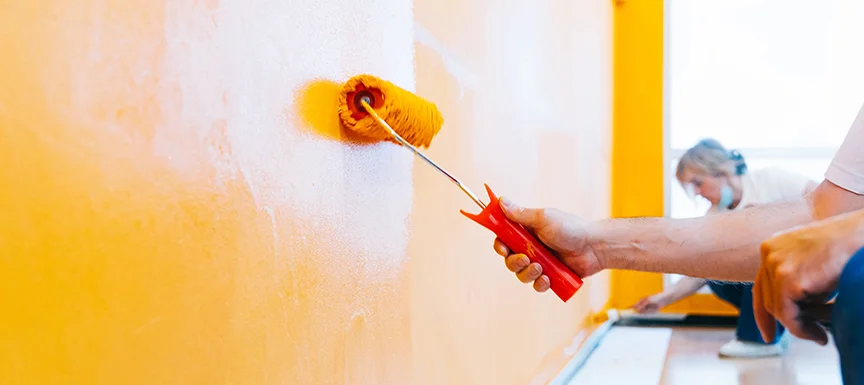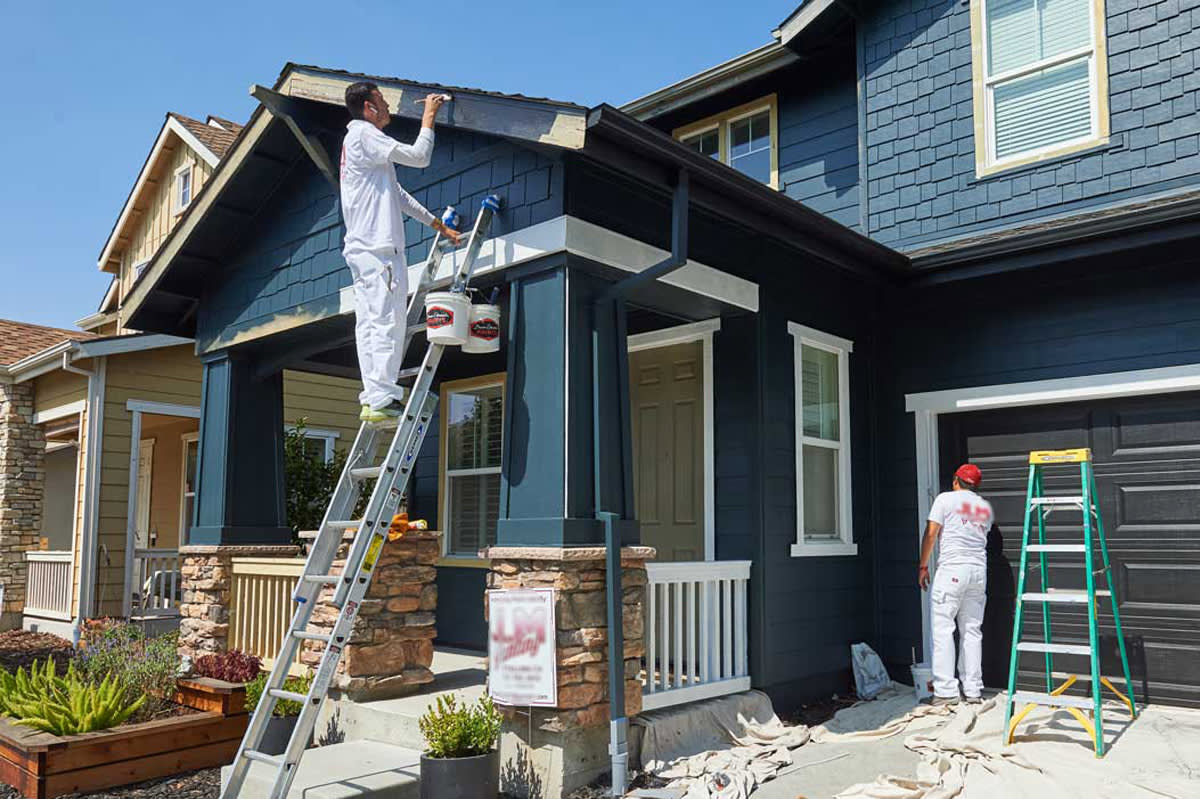Discovering the Different Kinds Of Paint: A Guide for each Task
Checking out the different kinds of paint is vital for attaining the desired end result in any type of project. From water-based choices that offer ease to oil-based paints known for their sturdiness, each option has its benefits. Specialized paints can include unique structures or coatings, while environmentally friendly choices provide to those seeking sustainability. Understanding these differences can considerably impact the success of a paint venture. What factors should one take into consideration when making the ideal choice?
Recognizing Paint Types: Water-Based vs. Oil-Based
Paint kinds can markedly influence a job's outcome, and recognizing the differences in between oil-based and water-based paints is necessary for notified decision-making. Water-based paints, frequently referred to as latex paints, are made up of water as the key solvent. They dry rapidly, release fewer volatile organic compounds (VOCs), and are very easy to cleanse up with soap and water. This makes them a popular choice for indoor applications and atmospheres where air quality is a concern.
On the other hand, oil-based paints utilize natural solvents, offering a durable, shiny surface ideal for surface areas subjected to damage, such as trim and cabinets. They take longer to completely dry, require mineral spirits for clean-up, and have a more powerful odor. paint store corpus christi tx. Choosing in between these two kinds relies on the certain needs of the project, taking into consideration elements such as wanted finish, application setting, and ease of upkeep. Each type has unique advantages and constraints, guiding the option process
The Complete Matters: Selecting Between Matte, Satin, and Gloss
When choosing a paint coating, the selection in between matte and shiny options significantly affects both visual appeals and performance. Matte surfaces supply a refined, non-reflective appearance that can hide surface imperfections, while glossy surfaces give sturdiness and convenience of cleaning. Comprehending the advantages and considerations of each can assist in making an educated choice for any painting project.
Matte Complete Advantages
Although lots of property owners dispute the advantages of various coatings, matte paint uses distinct advantages that make it a popular selection for both interior and exterior applications. One of the primary benefits of matte finish is its ability to hide surface area flaws, producing a smoother appearance on walls. This quality is specifically useful in older homes or spaces with unequal surface areas. In addition, matte paint absorbs light instead than mirroring it, which can enhance the visual of a space by providing a much more sophisticated and low-key look. Moreover, matte surfaces are frequently less complicated to retouch than glossier options, as they can mix more effortlessly when applied over existing paint. In general, matte paint is an outstanding selection for those seeking a refined and sophisticated finish.
Shiny Finish Factors To Consider
A glossy surface can drastically alter the assumption of an area, offering a reflective and smooth top quality that enhances both shade vibrancy and light within a room. This surface is often preferred for high-traffic areas and surface areas like kitchen areas and washrooms, where longevity and simplicity of cleansing are important. Nonetheless, its reflective nature can highlight imperfections on wall surfaces, making proper surface area prep work vital. Glossy paints also often tend to reveal spots and finger prints extra conveniently, demanding normal upkeep. In addition, lighting plays a significant role; in bright settings, a shiny coating might develop glow, impacting the overall aesthetic. Consequently, careful consideration of the specific application and environment is important when choosing a shiny coating for any project.
Specialized Paints: When to Use Distinctive or Chalk Paint
Specialized paints, such as textured and chalk paint, offer special visual and useful advantages that can improve numerous surfaces. Textured paint is suitable for creating depth and dimension on wall surfaces, concealing blemishes while including a three-dimensional feeling. It is especially useful in high-traffic locations where longevity and visual rate of interest are essential.

Both kinds of specialty paints can transform spaces, but choosing the right one depends upon the preferred impact and surface requirements. Textured paint might match larger locations, while chalk paint can renew smaller sized things, showcasing creative thinking and individual design in any kind of task.
Exterior Paints: Protecting Your Surface Areas From the Components
Exterior paints are crucial for safeguarding surfaces against various climate condition. Understanding their weather condition resistance functions, appropriate surface preparation needs, and effective application techniques can substantially enhance sturdiness and efficiency. This area will certainly lay out vital considerations for selecting and making use of exterior paints properly.
Weather Resistance Includes
Weather condition resistance is a necessary attribute of exterior paints, as it establishes exactly how well surfaces can withstand the severe components of nature. High-quality exterior paints are formulated to stand up to damage from UV rays, dampness, and temperature variations. UV resistance assurances shades stay vivid with time, avoiding fading and staining. Moisture resistance shields against mold and mold, which can compromise the stability of surfaces. Furthermore, paints with superb temperature resistance can increase and contract without cracking, preserving their safety qualities. When choosing exterior paints, it is important to think about these weather resistance functions, as they add to the longevity and toughness of painted surfaces, making specific they continue to be visually pleasing and useful despite exposure to the aspects.
Surface Preparation Demands
Correct surface preparation is an essential action in attaining the very best results with exterior paints. To assure perfect bond and resilience, surface areas must be completely cleaned up, getting rid of dirt, mildew, and oil. This can be completed making use of a pressure washer or a scrub brush with an ideal cleaning service. When cleaned up, surfaces ought to be examined for any type of peeling or flaking paint, which should be scuffed away to create a website smooth foundation. Repairing any kind of splits or openings is likewise crucial, as these can permit dampness seepage. Furthermore, fining sand rough areas promotes better paint bond. Applying a primer suited for outside usage can boost the paint's performance, guaranteeing a lasting surface that holds up against the components. Correct prep work is key to a successful outdoor painting project.
Application Techniques Tips
While applying outdoor paints, it is vital to utilize effective techniques that guarantee surfaces are well-protected against the components. Initially, select the right day for paint; low moisture and moderate temperatures improve adhesion and drying. Prepping the surface extensively-- cleaning, fining sand, and priming-- guarantees far better paint adhesion and longevity. Utilizing high-quality brushes or rollers can give a smoother surface, while spray paint might cover large locations effectively. Applying paint in slim, even layers avoids drips and runs. It is a good idea to comply with maker instructions concerning drying out times between layers. Verify correct ventilation throughout application to help with drying out and reduce exposure to fumes. These methods greatly improve the long life and effectiveness of exterior paint.
Eco-Friendly Options: Low-VOC and Zero-VOC Paints
As customers become significantly familiar with the ecological impact of their options, zero-voc and low-voc paints have actually emerged as preferred choices. These paints are created to include less unpredictable organic substances (VOCs), which are chemicals that can vaporize into the air and add to air contamination and health problems. Low-VOC paints commonly contain a limited amount of VOCs, while zero-VOC paints have negligible levels, making them safer for both outdoor and indoor use.
The benefits of making use of zero-voc and low-voc paints expand past ecological factors to consider; they likewise enhance interior air top quality, reducing the risk of respiratory issues and allergies. Numerous producers currently supply a selection of shades and finishes in eco-friendly options, making it easier for customers to locate ideal products for their jobs. By selecting these paints, people can add to a much healthier atmosphere while still accomplishing the visual they desire in their rooms.
Devices and Methods for a Perfect Application
Attaining a remarkable paint application calls for the right devices and strategies, which can greatly enhance the last outcome. Choosing the suitable brush or roller is vital; brushes work well for sides and complex areas, while rollers cover larger surface areas effectively. Utilizing top quality materials ensures much better paint circulation and decreases touches. For optimal results, surface area prep work is crucial. This consists of cleansing, fining sand, and priming surfaces to advertise adhesion.
Method also plays a considerable function. The "W" approach with a roller helps to equally distribute paint, while long, smooth strokes with a brush stop noticeable lines. Operating in areas enables better control and blending. In addition, applying thin layers is better to thick layers, decreasing the threat of drips and irregular textures. Lastly, keeping a wet edge during application aids attain seamless modifications in between locations. By incorporating these methods and devices, one can achieve a refined and specialist coating.
Tips for Maintaining and Caring for Your Painted Surfaces
Proper maintenance and treatment of painted surfaces can considerably expand their lifespan and preserve their appearance. Routine cleansing is important; utilizing a soft fabric or sponge with light soap and water can eliminate dirt and dust without harming the paint. It is advisable to prevent rough cleansers or rubbing pads, as these can scratch the surface. In addition, using a fresh layer of paint every few years can rejuvenate the shade and protect versus wear.
For outdoor surface areas, evaluating for signs of peeling or fading consistently is important. Immediately resolving any kind of issues avoids additional damage. In areas prone to moisture, such as restrooms, making use of mold-resistant paint and making certain proper ventilation can help maintain the integrity of the paint. Finally, using safety coatings can secure versus UV rays and spots, making certain that painted surfaces remain lively and attractive for many years ahead, eventually boosting the general visual of the area.
Frequently Asked Concerns
Can I Mix Different Kind Of Paint With Each Other?
Mixing various kinds of paint is generally not recommended, as it can result in problems like bad bond, irregular structure, or unanticipated chemical responses. It's best to use compatible paints for perfect results and longevity.

Exactly how Do I Correctly Store Extra Paint?
To correctly store leftover paint, seal the container tightly, tag it with the day and shade, and keep it in a cool, dry area away from straight sunshine and severe temperatures for perfect conservation.
What Is the most effective Way to Get Rid Of Extra Paint?
The ideal way to deal with unused paint is to inspect neighborhood laws, as many areas have assigned harmful waste centers. Alternatively, consider contributing useful paint to community companies or colleges for their projects.
How Can I Tell if Paint Is Still Great to Make Use Of?
To determine if paint is still excellent, examine its smell, color, and consistency. If it appears separated, has an unpleasant odor, or shows considerable adjustments in appearance, it's likely no more useful.
Exist Age Restrictions for Buying Paint Products?
In numerous regions, there are no particular age restrictions for buying paint products. Some shops may need clients to be at least 18 years old, particularly for items consisting of solvents or unsafe products.
Paint kinds can significantly impact a project's result, and understanding the differences in between oil-based and water-based paints is necessary for informed decision-making. Water-based paints, often referred to as latex paints, are made up of water as the main solvent. In contrast, oil-based paints make use of organic solvents, providing a sturdy, shiny surface ideal for surface areas exposed to tear and use, such as trim and cabinets. Specialized paints, such as distinctive and chalk paint, deal unique visual and useful advantages that can improve different surfaces. In areas prone to dampness, such as washrooms, utilizing mold-resistant paint and guaranteeing proper air flow can assist preserve the integrity of the paint.